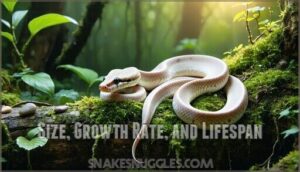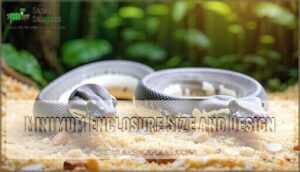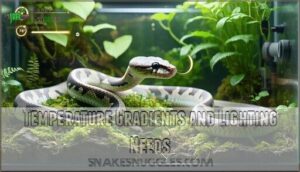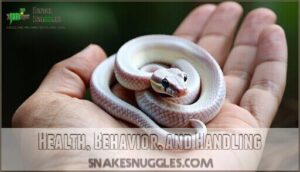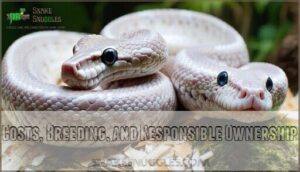This site is supported by our readers. We may earn a commission, at no cost to you, if you purchase through links.
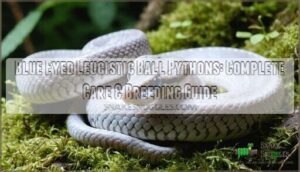 You’ll find that blue eyed leucistic ball pythons everything you need to know starts with understanding their genetics. These stunning snakes aren’t a separate species but designer morphs created by combining BEL complex genes like Lesser, Butter, Mojave, and Russo. **When you pair any two BEL genes, you’ll get pure white scales and piercing blue eyes.
You’ll find that blue eyed leucistic ball pythons everything you need to know starts with understanding their genetics. These stunning snakes aren’t a separate species but designer morphs created by combining BEL complex genes like Lesser, Butter, Mojave, and Russo. **When you pair any two BEL genes, you’ll get pure white scales and piercing blue eyes.
**
They’re manageable at 3-5 feet long and need proper temperature gradients, humidity control, and a 4x2x2-foot enclosure minimum. **Their striking appearance comes from co-dominant genetics that create thousands of possible combinations.
** The real magic happens when you understand how specific breeding combinations reveal different visual traits.
Table Of Contents
- Key Takeaways
- What Are Blue Eyed Leucistic Ball Pythons?
- Appearance and Physical Traits
- Ideal Habitat and Enclosure Setup
- Feeding and Nutrition Guidelines
- Health, Behavior, and Handling
- Costs, Breeding, and Responsible Ownership
- Frequently Asked Questions (FAQs)
- What are some facts about blue eyed leucistic ball pythons?
- How to produce blue eyed leucistic ball in python?
- Are blue-eyed leucistic ball pythons poisonous?
- How does the BLUE affect environmental awareness?
- Can you train a BLUE for specific behaviors?
- What social behavior do BLUES exhibit with other snakes?
- Are there famous BLUE specimens known in the community?
- How do BLUES react to music or noise?
- Can blue eyed leucistics be housed together?
- Do BEL pythons have vision problems?
- Conclusion
Key Takeaways
- You’ll create these stunning white snakes with blue eyes by breeding any two ball pythons from the BEL complex (Lesser, Butter, Mojave, or Russo genes) – it’s all about genetics, not a separate species.
- You’ll need a 4x2x2-foot enclosure minimum with proper temperature gradients (88-92°F warm side, 78-82°F cool side) and 50-60% humidity to keep your snake healthy.
- You’re looking at a 20-30 year commitment with costs ranging from $300-1,500 initially, plus ongoing monthly expenses of $10-15 for feeding and annual vet bills of $100-200.
- You’ll find these docile snakes manageable at 3-5 feet long, eating frozen-thawed prey every 10-14 days as adults, making them suitable for both beginners and experienced keepers.
What Are Blue Eyed Leucistic Ball Pythons?
You’re looking at a stunning genetic morph created by combining genes from the BEL complex, which includes Lesser, Butter, Mojave, Mocha, and Russo mutations. These produce pure white scales and enchanting blue eyes.
Nature’s masterpiece in white and blue—pure genetics creating living art
These aren’t a separate species but rather a carefully bred variation of the common ball python. This is achieved when you pair any two compatible genes from this complex to create what’s basically nature’s own masterpiece in reptile form.
Morph Genetics and BEL Complex
Understanding blue-eyed leucistic ball python genetics starts with the BEL complex, which includes genes like Lesser, Butter, Mojave, and Russo. These co-dominant genes create designer morphs when paired together. You’ll get BEL gene combos producing white snakes with blue eyes, though some combinations cause incomplete leucism with subtle color variations.
Understanding how genetic variation leads to thousands of color and pattern combinations is key. Visual identifiers help distinguish true BELs from similar ball python morphs, while proper ball python breeding considers genetic health factors.
Origins and Creation of The BEL Morph
The blue eyed leucistic ball python emerged through strategic breeding programs combining specific BEL Gene Combinations from the leucistic complex. Breeders discovered that pairing certain Ball Python Morphs like Lesser, Butter, Mojave, and Russo creates these stunning Designer Morphs.
This advancement in Leucism Genetics and Morph Development revolutionized Ethical Breeding practices, giving reptile enthusiasts access to these notable blue eyed lucy specimens.
Unique Traits and Why They’re Special
What makes blue eyed leucistic ball pythons truly stand out? These white snakes captivate with their striking blue eyes and flawless appearance. Their genetic combinations create visual appeal that’s hard to match.
Beyond looks, blue eyed lucy ball pythons often display calmer temperament differences compared to normal morphs. Rarity factors drive demand, as leucistic ball python specimens remain relatively uncommon in collections.
They can grow to be approximately 3-5 feet long, making them a manageable size for many keepers.
Appearance and Physical Traits
When you first see a blue eyed leucistic ball python, you’ll notice their striking pure white scales that create a clean, almost porcelain-like appearance across their entire body.
Their most enchanting feature remains those piercing blue eyes, which contrast dramatically against their snow-white coloration and make these snakes instantly recognizable among ball python morphs.
Coloration and Eye Color
Witnessing a blue eyed leucistic ball python reveals nature’s artistic mastery. These snakes display pure white scales with subtle cream undertones, creating stunning albinism contrast against their vibrant blue eyes.
Blue eye genetics from BEL complex morph combinations produce varying color intensity levels. Some blue eyed lucy specimens show faint pattern influence, while others achieve complete leucistic flawlessness with crystalline clarity.
Size, Growth Rate, and Lifespan
Your blue eyed lucy ball python will reach 3-5 feet as an adult, with females usually growing larger than males. Hatchlings start at 10-17 inches and experience rapid Growth Rate Factors during their first two years. Adult Size Variation depends on genetics and care quality.
Like reticulated pythons, their growth can be influenced by environmental temperature gradients. With proper husbandry, these ball pythons boast impressive Lifespan Potential of 20-30 years, though Size vs. Health correlates directly with consistent feeding schedules and ideal temperatures throughout juveniles to adults stages.
Common Variations Within The BEL Morph
Not all blue-eyed leucistic ball pythons look identical. Morph combinations create fascinating pattern variations and intensity differences across genetic lineages.
Classic BELs from Mojave × Lesser pairings produce pure white snakes, while Mystic Potion morphs display lavender-gray patches. Some retain faint dorsal striping or creamy hues.
These snakes are genetically distinct from other morphs. Future morphs continue expanding possibilities within leucistic ball python breeding programs.
Ideal Habitat and Enclosure Setup
Creating the right habitat for your blue eyed leucistic ball python requires careful attention to temperature, humidity, space, and environmental enrichment to guarantee your snake thrives in captivity.
You’ll need to establish proper thermal gradients, maintain consistent humidity levels, choose appropriate substrate materials, and provide essential hiding spots that mimic their natural African grassland environment.
Minimum Enclosure Size and Design
Your blue eyed lucy ball python needs room to move and feel secure. A 4′ x 2′ x 2′ enclosure provides adequate space utilization for adults, though bigger is always better.
Consider these Enclosure Enrichment essentials:
- Multiple hide boxes for Security Features
- Substrate Depth of 2-3 inches for burrowing
- Horizontal layout maximizing floor space
- Separate Thermal Zones for thermoregulation
Proper enclosure size directly impacts your ball python’s stress levels and overall health.
Temperature Gradients and Lighting Needs
Your ball python’s enclosure needs proper temperature gradients to support healthy thermoregulation. Create a basking spot temp of 88-92°F on the warm side, while maintaining a cool side range of 78-82°F. Nighttime temperatures can drop 2-3 degrees safely.
For lighting options, use ceramic heat emitters or under-tank heaters rather than bright lights. Consider a quality ball python heater to maintain consistent temperatures.
Seasonal adjustments aren’t necessary since ball python care requires consistent temperature and humidity year-round in your enclosure.
Humidity Requirements and Substrate Choices
Proper humidity monitoring becomes your first line of defense against health concerns in ball python care. You’ll need 50-60% humidity, with coconut husk or cypress mulch as ideal substrate choices for moisture retention.
These substrates prevent shedding issues while supporting your snake’s burrowing needs. Many keepers find suitable substrate options readily available online.
Monitor temperature and humidity with digital hygrometers, maintaining 3-5 inch substrate depth. Avoid misting directly—instead, pour water into lower substrate layers for mold prevention and consistent enclosure conditions.
Essential Hides and Climbing Structures
Creating secure hideouts transforms your blue eyed leucistic ball python’s enclosure into a stress-free sanctuary. You’ll need at least two hides—one on each temperature zone—sized snugly enough that your snake feels secure but can still fit comfortably.
Choose materials like ceramic or plastic that retain heat well, and add climbing branches for Enclosure Enrichment and exercise.
Regular cleaning helps prevent bacteria growth.
Feeding and Nutrition Guidelines
You’ll need to establish a consistent feeding schedule that matches your blue eyed leucistic ball python’s age and size, using appropriately sized prey items that don’t exceed the snake’s widest body circumference.
Understanding the differences between live and frozen-thawed prey options, along with recognizing common feeding challenges, will help you maintain your snake’s ideal health and nutrition throughout its 20-30 year lifespan.
Recommended Prey Types and Sizes
Your blue-eyed Lucy ball python’s feeding success depends heavily on choosing appropriate prey types and sizes. These obligate carnivores thrive on frozen-thawed prey that matches their natural dietary needs.
Here’s your prey selection guide:
- Prey Size Progression: Match prey width to your snake’s thickest body section
- Sourcing Quality Prey: Purchase from reputable suppliers ensuring proper nutritional value
- Frozen-Thawed Prey: Safer than live options, reducing injury risk during feeding
- Supplementing Prey Items: Occasionally dust with calcium for ideal health
Following proper feeding instructions prevents handling and refusal-to-eat issues. To prevent health issues, verify prey isn’t oversized.
Feeding Frequency by Age
Young ball pythons eat more frequently than adults, with age determining your feeding schedule. Hatchlings need meals every 5-7 days to support rapid growth, while juveniles maintain similar intervals.
Adult blue eyed lucy ball pythons require feeding every 10-14 days, preventing obesity risks common with overfeeding.
Consistent refeeding strategies using frozen-thawed prey help establish healthy patterns throughout your snake’s life.
Live Versus Frozen/Thawed Prey
Should you choose live or frozen-thawed prey for your blue eyed lucy ball python? Frozen-thawed prey offers better safety, eliminating bite risks and parasite transmission while maintaining excellent prey nutritional value. Thawing frozen prey properly ensures ideal feeding conditions.
Live prey requires careful handling and raises ethical considerations about animal welfare. Most experienced keepers prefer frozen-thawed options for consistent, stress-free feeding sessions with their ball python.
Addressing Feeding Challenges
Some blue eyed leucistic ball pythons can be finicky eaters, especially young snakes. If your ball python refuses frozen-thawed prey, try scenting techniques like rubbing the prey with chick or quail.
Regurgitation causes include overhandling or wrong temperatures. Avoid assisted feeding unless absolutely necessary.
Monitor feeding frequency to prevent obesity—even blue eyed lucy ball pythons can become overweight with excessive feeding.
Health, Behavior, and Handling
You’ll need to monitor your blue eyed leucistic ball python’s health closely, as these stunning white snakes can develop respiratory infections, mites, and scale rot when their environment isn’t properly maintained.
Understanding their naturally docile temperament and learning proper handling techniques will help you recognize early signs of illness while building trust with your snake through gentle, confident interactions.
Common Health Concerns and Prevention
What health challenges might your blue eyed leucistic ball python face? Respiratory infections from improper temperature and humidity top the list, alongside mite infestations and scale rot from poor enclosure hygiene. Genetic issues rarely occur in captive-bred specimens.
Preventative care through proper environmental controls, regular cleaning, and routine veterinary care prevents most problems before they start.
Signs of Stress and Illness
Watch for behavioral changes like excessive hiding, refusing food, or unusual aggression in your python.
Shedding issues, including stuck shed or prolonged shedding cycles, often signal incorrect temperature or humidity levels.
Respiratory signs such as mouth breathing, wheezing, or mucus discharge indicate respiratory infections requiring immediate veterinary care.
Scale abnormalities like discoloration or soft spots suggest scale rot from poor enclosure conditions.
Proper Handling Techniques
During and after handling sessions, your blue-eyed lucy ball python’s comfort depends on recognizing cues and reducing stress. Support their body weight with both hands for safe lifting, avoiding sudden movements that trigger defensive responses.
Move slowly when removing your ball python from their enclosure, avoiding bites through gentle, confident movements.
- Recognizing Cues: Watch for defensive posturing, hissing, or ball formation before handling
- Safe Lifting: Support the snake’s body at multiple points, never grabbing just the head or tail
- Handling Frequency: Limit sessions to 10-15 minutes, 2-3 times weekly to prevent stress
Regular Veterinary Care and Check-Ups
Your blue-eyed Lucy ball python needs preventative care from an experienced reptile vet. Schedule annual checkups for fecal exams and parasite prevention. When selecting a vet, verify they specialize in reptiles. Quarantine protocols prevent disease spread. Emergency care might be needed for respiratory infections or mites. Consider telehealth options too.
| Care Type | Frequency |
|---|---|
| Wellness Exam | Annual |
| Fecal Testing | Annual |
| Weight Monitoring | Monthly |
Costs, Breeding, and Responsible Ownership
Before you commit to purchasing a blue eyed leucistic ball python, you’ll need to understand the significant financial investment. Initial costs range from $300 to $1,500 for the snake itself, plus ongoing expenses for housing, feeding, and veterinary care.
Breeding these morphs requires careful genetic planning and knowledge of the BEL complex, while responsible ownership means ensuring you’re prepared for a 20-30 year commitment with proper legal compliance and ethical considerations.
Purchase Price and Ongoing Expenses
Budgeting for ownership isn’t just about the Initial Cost—blue-eyed Lucy ball pythons usually range from $200-$600.
Monthly Feeding Expenses for frozen-thawed prey average $10-15. Factor in Veterinary Care ($100-200 annually), potential Enclosure Upgrades, and Unexpected Costs like medical emergencies.
Smart owners keep $500+ emergency funds ready, because ball pythons for sale from quality breeders deserve lifelong proper care.
Finding Reputable Breeders
Your reputable breeder search should focus on ethical practices and quality. Look for these key indicators:
- Health guarantees and genetic testing documentation for parent lineage transparency
- Breeder reputation through customer reviews and community feedback
- Captive-bred certifications with detailed breeding records and health protocols
- Ethical breeding practices including proper husbandry and animal welfare standards
- Specialized blue eyed lucy ball python knowledge from established facilities like Wilbanks Reptiles
Research thoroughly before committing to your purchase.
Breeding BEL Pythons and Genetic Considerations
Once you’ve found your trusted breeder, understanding BEL Complex Genes becomes your next adventure. Breeding Pair Selection requires combining any two morphs from the Lesser, Mojave, Butter, Russo, or Bamboo lines. Each pairing yields 25% BEL offspring on average.
| Gene Combination | BEL Probability | Common Defects |
|---|---|---|
| Lesser x Mojave | 25% per egg | Minimal eye issues |
| Super Lesser | 100% white | Possible bug eyes |
| Butter x Russo | 25% per egg | Rare defects |
| Multi-gene cross | Variable | Complex tracking needed |
Ethical breeding practices demand detailed record-keeping and genetic transparency for your blue eyed lucy ball python lineage.
Legal, Ethical, and Special Care Factors
Before diving into blue-eyed leucistic ball python ownership, you’ll need to navigate the legal landscape and ethical considerations. Responsible ownership starts with understanding regulations in your area and sourcing from ethical breeders who prioritize morph health through captive breeding practices.
- Legality overview: Check local and state laws before purchase—some areas restrict python ownership
- Ethical sourcing: Only buy captive-bred specimens from reputable breeders using ethical breeding practices
- Long-term commitment: Plan for a 20-30 year lifespan with consistent care requirements
- Morph health: Understand that leucistic ball pythons need specialized monitoring for genetic issues
- Community responsibility: Support ethical breeding by avoiding wild-caught or questionable sources
Frequently Asked Questions (FAQs)
What are some facts about blue eyed leucistic ball pythons?
These absolutely stunning snakes aren’t a separate species—they’re genetic morphs created by combining two BEL complex genes.
You’ll find they’re docile, live 20-30 years, need specific temperatures, and display pure white scales with mesmerizing blue eyes.
How to produce blue eyed leucistic ball in python?
You’ll need to breed two ball pythons carrying genes from the BEL complex. Pair any two of these morphs: Lesser, Butter, Mojave, Mocha, or Russo. The offspring will be white with blue eyes.
Are blue-eyed leucistic ball pythons poisonous?
Blue-eyed leucistic ball pythons aren’t poisonous at all. These stunning white snakes with blue eyes are actually non-venomous constrictors, meaning they squeeze their prey rather than inject toxins. **You’re perfectly safe handling them.
How does the BLUE affect environmental awareness?
Like windows to your snake’s soul, those striking azure eyes don’t improve environmental awareness.
Ball pythons rely heavily on chemical cues from their forked tongues and heat-sensing abilities rather than vision for traversing their surroundings.
Can you train a BLUE for specific behaviors?
Training ball pythons for specific behaviors isn’t realistic. You can’t teach them tricks like dogs.
They’ll become accustomed to handling and may recognize feeding routines, but complex behavioral training simply isn’t possible with these reptiles.
What social behavior do BLUES exhibit with other snakes?
Recent studies reveal 96% of ball pythons exhibit social clustering behavior. Contrary to popular belief, your BEL doesn’t need solitude—they’ll often huddle with other snakes when given the choice, though territorial stress can still occur.
Are there famous BLUE specimens known in the community?
While no single "celebrity" specimens dominate the BEL community like famous racehorses, you’ll find standout bloodlines from top-tier breeders like Kinova and BHB Reptiles, whose outstanding breeding programs produce highly coveted animals.
How do BLUES react to music or noise?
Silent vibes — your blue-eyed lucy doesn’t "hear" music traditionally. Ball pythons can hear some airborne sound, but not well, sensing mainly vibrations, so sudden, loud thuds or stomping noises are likely to startle or scare them.
Can blue eyed leucistics be housed together?
You shouldn’t house blue eyed leucistics together. Ball pythons are naturally solitary creatures who prefer living alone, and cohabitation increases stress, competition for resources, and disease transmission risks.
Do BEL pythons have vision problems?
BEL pythons don’t have unique vision problems compared to regular ball pythons. Their eyesight works normally, though all ball pythons have naturally poor daytime vision and rely on heat-sensing abilities.
Conclusion
Picture yourself gazing into those mesmerizing sapphire eyes as your snake coils contentedly around your arm. Blue eyed leucistic ball pythons are truly captivating creatures.
Everything you need to know about these snakes encompasses their fascinating genetics, straightforward care requirements, and the rewarding ownership experience. You’ve discovered these aren’t just beautiful pets, but living art pieces created through careful breeding.
With proper husbandry, temperature control, and regular veterinary care, you’ll enjoy decades with your stunning white serpent. Their docile nature and manageable size make them perfect for both beginners and experienced keepers seeking something unique.
- https://www.morphmarket.com/morphpedia/ball-pythons/russo/
- https://www.xyzreptiles.com/product/baby-blue-eyed-leucistic-ball-python/
- https://www.wilbanksreptiles.com/blogs/caring-for-blue-eyed-lucy-ball-pythons/caring-for-blue-eyed-lucy-ball-pythons
- https://amccorona.com/wp-content/uploads/2020/05/ARAV_trifold_ball_pythonv2_2.pdf
- https://community.morphmarket.com/t/blue-eye-leucistic-complex/42651


